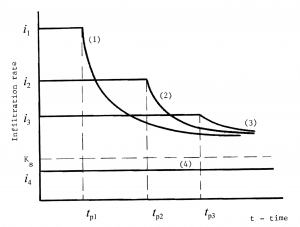6.3 Infiltration for a Constant Rainfall Rate
The Green-Ampt model described in the prior section is only valid for ponded infiltration. It does not provide infiltration predictions for the case when water is supplied to the soil surface, by rain or sprinkler irrigation, at a rate below the soil’s infiltration capacity. In 1971, engineers Russell Mein and Curtis Larson at the University of Minnesota made an important breakthrough by modifying the Green-Ampt model to account for the case of infiltration under constant-rate rainfall [7]. They reasoned that if rain is reaching the soil surface at a constant rate that is below the soil’s initial infiltration capacity but above the soil’s saturated hydraulic conductivity then initially all the water will infiltrate as it reaches the surface. During that stage, infiltration is supply controlled, i.e. the rate of water delivery to the surface limits the infiltration rate. However, since the soil’s infiltration capacity decreases over time during an event, a distinct point in time will be reached when the infiltration capacity falls below the rainfall rate and water will begin to accumulate, or pond, on the surface. After this time, infiltration is soil controlled, i.e. the rate of water flow in the soil limits the infiltration rate. Only after this change point is reached can runoff begin. Study Fig. 6‑4 for a graphical representation of this conceptual model for the infiltration process.

The Mein and Larson modification of the Green-Ampt model provides a simple three-step way to estimate this time to ponding. The first step is to note that ponding begins the moment when the rainfall rate, r, equals the soil’s infiltration capacity, i, as defined by the Green-Ampt ponded infiltration equation, Eq. 6-2. Substituting r for i in Eq. 6-2, assuming H0 = 0, and solving for Lf gives:
![]()
(Eq. 6-5)
which defines the depth of the wetting front when ponding begins. Next, the cumulative infiltration, I, that has occurred prior to ponding is estimated by inserting this Lf value in Eq. 6-3. Finally, the time required for the rainfall rate, r, to supply the cumulative water depth, I, is estimated by:
![]()
(Eq. 6-6)
where tp is the time required for ponding to occur.

